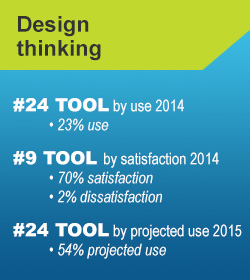Design thinking refers to a distinctive process of developing innovative solutions that is rooted in principles of physical, spatial, graphic, and user-interface design. It is characterized by an emphasis on deeply understanding the practical needs, behavior, and perspectives of actual users and constituents and may be applied to a wide variety of challenges, including programs, services, products, and processes. It is an action-oriented approach to generating creative solutions to complex problems.
How it's used
Design thinking combines intuitive and analytical thinking. It equips individuals and organizations with a process to first gain a deep understanding of constituents' perspectives, and then rapidly develop and test culturally and contextually relevant, viable solutions to problems. Nonprofits may use design thinking to generate innovative solutions in a range of scenarios, such as addressing a particular challenge, reframing questions and decisions, in a larger process of strategic planning, or integrating constituent engagement.
Methodology
Design thinking can be implemented as a distinct process over a period of several months, or it can be embedded within a larger, ongoing strategic planning process. Organizations may wish to engage an outside facilitator or can use free online guides (see additional resources) to implement design thinking methodologies on their own.
Combining approaches from IDEO, Stanford's Hasso Plattner Institute of Design (d.school) and Rotman School of Management DesignWorks, there are four general phases to design thinking:
- Gain inspiration from constituents: The first step in design thinking is gaining a deep understanding of constituents' perspectives. Using qualitative, ethnographic methods, such as shadowing a service beneficiary to observe his or her needs and behaviors, participants should seek to truly empathize with and understand their beneficiaries' worlds and needs. Using this perspective, the problem facing beneficiaries can be reframed and defined.
- Generate ideas collectively: With a truer understanding of the constituent perspective, organizers can gather an interdisciplinary team to rapidly brainstorm potential solutions to the defined problem. This process should be generative and iterative, so brainstorming all possible ideas is a good place to start. From here, participants can begin to segment and prioritize some ideas over others to identify feasible solutions.
- Develop best ideas: Rapidly prototype potential programs, services, products, or processes from the idea-generation phase. Test iteratively with end users to incorporate their feedback and improve the solution.
- Convert into a sustainable strategy: Develop a business model that enables the organization to deliver the solution in an economically viable and scalable fashion.
Related topics
Additional resources
Design Thinking for Social Innovation
The CEO and president of IDEO and the leader of its Social Innovation group introduce the concept and use of design thinking in the social sector, complete with examples of its application.
Virtual Crash Course in Design Thinking
For those interested in a deeper dive into implementing design thinking, this 90-minute video-led experience provides users with a workshop in Stanford's approach to the subject.
This toolkit from IDEO.org provides nonprofits with a guide to implementing design thinking.
The Design of Business: Why Design Thinking Is the Next Competitive AdvantageThis book by Roger Martin, the Premier’s Chair in Productivity and Competitiveness and Academic Director of the Martin Prosperity Institute at the Rotman School of Business, explains how organizations can use design thinking to innovate to competitive advantage.
DesignWorks: How to Tackle your Toughest Innovation Challenges through Business Design This book by Heather Fraser, co-founder and director of Rotman DesignWorks, provides a three-part process for implementing design thinking.
Examples and case studies
Shaping a School System, From the Ground Up
Tasked with designing a new network of low-cost private schools in Peru, IDEO worked with Innova Schools to develop a new approach to learning. To date, Innova's students significantly outperform the national average on math and reading proficiency.
Embrace
Students at Stanford's d.school were challenged to develop a new solution to keeping infants warm in Nepal through low-cost infant warmers. Using design thinking methodologies, the students developed a breakthrough product that works.


